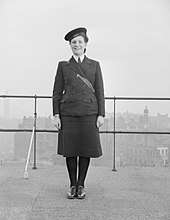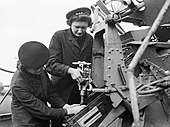Women's Royal Naval Service
The Women's Royal Naval Service (WRNS; popularly and officially known as the Wrens) was the women's branch of the United Kingdom's Royal Navy. First formed in 1917 for the First World War, it was disbanded in 1919, then revived in 1939 at the beginning of the Second World War, remaining active until integrated into the Royal Navy in 1993. WRNs included cooks, clerks, wireless telegraphists, radar plotters, weapons analysts, range assessors, electricians and air mechanics.


History
The Wrens were formed in 1917 during the First World War. On 10 October 1918, nineteen-year-old Josephine Carr from Cork, became the first Wren to die on active service, when her ship, the RMS Leinster was torpedoed. By the end of the war the WRNS had 5,500 members, 500 of them officers. In addition, about 2,000 members of the WRAF had previously served with the WRNS supporting the Royal Naval Air Service and were transferred on the creation of the Royal Air Force. It was disbanded in 1919.
The WRNS was revived in 1939 at the beginning of the Second World War, with an expanded list of allowable activities, including flying transport planes. At its peak in 1944 it had 75,000 active servicewomen. During the war there were 100 deaths. One of the slogans used in recruiting posters was "Join the Wrens—free a man for the fleet."
The WRNS remained in existence after the end of the war. In the 1970s it became obvious that equal pay for women and the need to remove sexual discrimination meant that the WRNS and the Royal Navy would become one organisation. The key change was that women would become subject to the Naval Discipline Act 1957. Vonla McBride, who had experience in human resource management, became the Director of the WRNS in 1976, and members of the WRNS were subject to the same discipline as men by the next year.[1]
In October 1990, during the Gulf War, HMS Brilliant carried the first women officially to serve on an operational warship.[2] That same year, Chief Officer Pippa Duncan became the first WRNS officer to command a Royal Navy shore establishment.[3][4] The WRNS was finally integrated into the Royal Navy in 1993, when women were allowed to serve on board navy vessels as full members of the crew. Female sailors are still informally known by the nicknames "wrens" or "Jennies" ("Jenny Wrens") in naval slang.
Before 1993, all women in the Royal Navy were members of the WRNS except nurses, who joined (and still join) Queen Alexandra's Royal Naval Nursing Service, and medical and dental officers, who were commissioned directly into the Royal Navy, held RN ranks, and wore WRNS uniform with gold RN insignia.
Ranks and uniform
The WRNS had its own ranking system, which it retained until amalgamation into the Royal Navy in 1993.
Officers
| NATO code | OF-10 | OF-9 | OF-8 | OF-7 | OF-6 | OF-5 | OF-4 | OF-3 | OF-2 | OF-1 | OF(D) | Student officer | ||||||||||||||||||||||||
|---|---|---|---|---|---|---|---|---|---|---|---|---|---|---|---|---|---|---|---|---|---|---|---|---|---|---|---|---|---|---|---|---|---|---|---|---|
1917-1919 |
No equivalent |  |
 |
 |
 |
 |
 |
 |
 |
 |
No equivalent | |||||||||||||||||||||||||
| Director | Deputy Director | Assistant Director | Deputy Assistant Director | Divisional Director | Deputy Divisional Director | Principle | Deputy Principle | Assistant Principle | ||||||||||||||||||||||||||||
(1939-1946)[5] (Edit) |
No equivalent |
 |
 |
 |
 |
 |
 |
 |
 |
No equivalent | ||||||||||||||||||||||||||
| Commandant | Director | Deputy Director | Superintendent | Chief Officer | First Officer | Second Officer | Third Officer | |||||||||||||||||||||||||||||
(1946-1951) (Edit) |
No equivalent |  |
 |
 |
 |
 |
 |
 |
No equivalent | |||||||||||||||||||||||||||
| Commandant | Director | Superintendent | Chief Officer | First Officer | Second Officer | Third Officer | ||||||||||||||||||||||||||||||
(1951-1993) (Edit) |
No equivalent |  |
 |
 |
 |
 |
 |
 |
No equivalent | |||||||||||||||||||||||||||
| Chief Commandant[6] | Commandant[7] | Superintendent | Chief Officer | First Officer | Second Officer | Third Officer | ||||||||||||||||||||||||||||||
Enlisted
| NATO Code | OR-9 | OR-8 | OR-7 | OR-6 | OR-5 | OR-4 | OR-3 | OR-2 | OR-1 | |||||||||||||||||||||||||||||||
|---|---|---|---|---|---|---|---|---|---|---|---|---|---|---|---|---|---|---|---|---|---|---|---|---|---|---|---|---|---|---|---|---|---|---|---|---|---|---|---|---|
1939-1993 |
No equivalent |  |
 |
No equivalent |  |
No equivalent |  |
 | ||||||||||||||||||||||||||||||||
| Chief Wren | Petty Officer Wren | Leading Wren | Wren | Ordinary Wren | ||||||||||||||||||||||||||||||||||||
Ratings' titles were suffixed with their trade (e.g. Leading Wren Cook, Chief Wren Telegraphist).
Wrens wore the same rank insignia as their male equivalents, but in blue instead of gold. The "curls" atop officers' rank stripes were diamond-shaped instead of circular.
From 1939, Wren uniform consisted of a double-breasted jacket and skirt, with shirt and tie, for all ranks (although similar working dress to the men could also be worn). Junior Ratings wore hats similar to those of their male counterparts (although with a more sloping top). Senior Ratings (Petty Officers and above) and officers wore tricorne hats with a white cover. All insignia, including cap badges and non-substantive (trade) badges, were blue.
List of Directors
- Dame Katharine Furse, 1917–1919
- Dame Vera Laughton Mathews, 1939–1946
- Dame Jocelyn Woollcombe, 1946–1950
- Commandant Dame Mary Lloyd, 1950–1954
- Commandant Dame Nancy Robertson, 1954–1958
- Commandant Dame Elizabeth Hoyer-Millar, 1958–1960
- Commandant Dame Jean Davies, 1961–1964
- Commandant Dame Margaret Drummond, 1964–1967
- Commandant Dame Marion Kettlewell, 1967–1970
- Commandant Daphne Blundell, 1970–1973
- Commandant Mary Talbot, 1973–1976
- Commandant Vonla McBride, 1976–1979
- Commandant Elizabeth Craig-McFeely, 1979–1982
- Commandant Patricia Swallow, 1982–1985
- Commandant Marjorie Fletcher, 1985–1988
- Commandant Anthea Larken, 1988–1991
- Commandant Anne Spencer, 1991–1993
See also
Notes
- Vat, Dan van der (2003-08-13). "Commandant Vonla McBride". The Guardian. ISSN 0261-3077. Retrieved 2017-07-09.
- History of the Women's Royal Naval Service and its integration into the Royal Navy
- Stuart Mason, Ursula (2011). Britannia's Daughters. Barnsley, South Yorkshire: Pen & Sword Military. p. 127. ISBN 978-1-84884-678-4.
- "Pipping Rest to Post". Navy News. March 1990. p. 11 – via issuu.
- Talbot-Booth, E.C. (1943). Ranks and Badges in the Navy, Army, RAF and Auxiliaries (PDF). London: George Philip & Son, Ltd. p. 30.
- Honorary rank held by a member of the Royal Family. Until 1951, the position was called Commandant, but was renamed in that year due to the introduction of Commandant as the rank for the Director WRNS. Princess Marina, Duchess of Kent was Commandant, and later Chief Commandant, from 1940 until her death in 1968. She was succeeded by Princess Anne, who held the appointment from 1974 until 1993, when she became Chief Commandant for Women, Royal Navy; she now holds the honorary rank of admiral.
- Until 1951, Director was both a position and a rank. In 1951, the rank of Commandant was introduced for the officer holding the position of Director. Director equated to Rear-Admiral until 1946, when it was reduced to Commodore. In common with RN Commodores, after 1946 Director/Commandant was only an appointment and not a true rank and the Directors continued to hold the substantive rank of Superintendent.
Further reading
- Fletcher, Marjorie H. (1989). The WRNS: A History of the Women's Royal Naval Service. Annapolis: Naval Institute Press. ISBN 9780870219979.
- Heath, Nick, Hacking the Nazis: The secret story of the women who broke Hitler's codes, TechRepublic, March 27, 2015
Memoirs
- Thomas, Lesley; Bailey, Chris Howard (2002). WRNS in Camera. Gloucestershire: Sutton Publishing.
- Unwin, Vicky (2015). Love and War in the WRNS. Gloucestershire: The History Press.
External links
| Wikimedia Commons has media related to Women's Royal Naval Service. |
